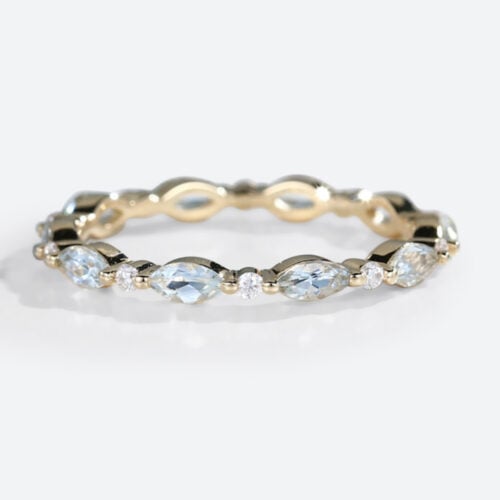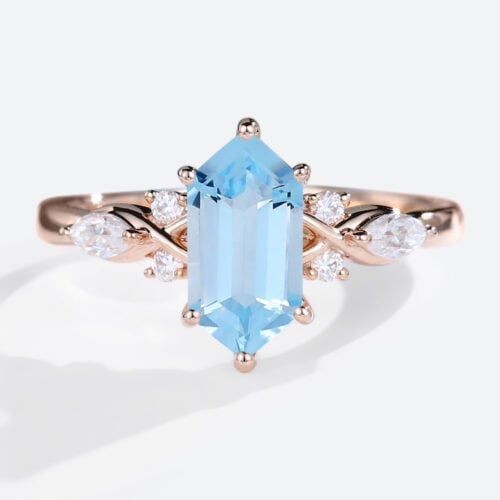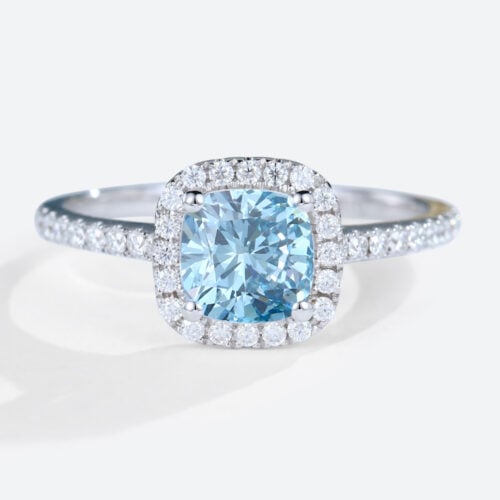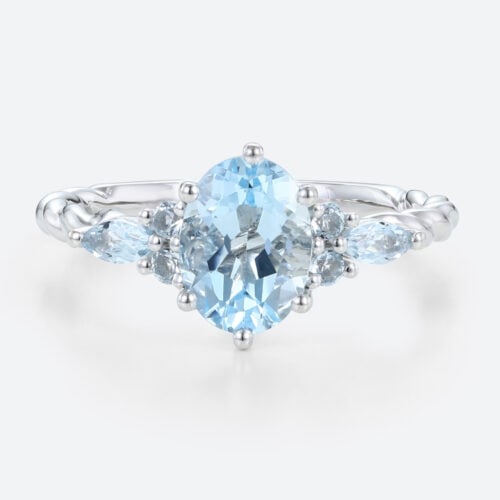Lab Grown Blue Diamonds vs Aquamarine: Which Blue Gemstone Is Right for You?
 Danae
DanaeI. The Allure of Blue Gemstones
Blue gemstones have long captivated jewelry lovers with their calming hues and timeless elegance. Among the most popular choices today are lab grown blue diamonds and Aquamarine, each offering unique beauty and appeal. Whether you’re searching for a stunning engagement ring or a statement piece, understanding the differences between these two blue gems can help you make an informed choice.
Both gems bring a distinctive charm to the table—while lab grown blue diamonds dazzle with unmatched brilliance and durability, Aquamarine enchants with its serene sea-blue shades and natural origins. This guide will take you through LisaJewelryUS' exploration of what makes each gemstone unique and which one might be the perfect choice for your next jewelry purchase.
II. What Are Lab Grown Blue Diamonds?
Lab grown blue diamonds are diamonds created in controlled laboratory environments, replicating the natural processes that form diamonds deep within the Earth. These gems possess the same chemical, physical, and optical properties as mined diamonds but offer several advantages that appeal to modern buyers.
One of the key features of lab grown blue diamonds is their exceptional brilliance and fire, delivering a sparkle that rivals, and sometimes even surpasses, their natural counterparts. The blue color in these diamonds results from the presence of boron during their creation, producing stunning shades ranging from soft pastel blues to deep, vivid tones.
Beyond their beauty, lab grown blue diamonds are celebrated for being more affordable and ethically sourced compared to mined diamonds. Choosing a lab grown blue diamond means embracing sustainability without compromising on quality or luxury—making them an increasingly popular choice for engagement rings, wedding bands, and fine jewelry.
III. What Is Aquamarine?
Aquamarine is a beautiful blue to blue-green variety of the mineral beryl, cherished for its soothing sea-like color and excellent clarity. Its name derives from the Latin words “aqua” (water) and “marina” (sea), perfectly capturing the gem’s tranquil hues that remind many of calm ocean waters.
Known for its relative affordability and wide availability, aquamarine has been a favorite gemstone for centuries, often symbolizing courage, serenity, and harmony. With a hardness of 7.5 to 8 on the Mohs scale, aquamarine is durable enough for everyday wear, though it requires a bit more care compared to diamonds.
Aquamarine’s natural origins and gentle blue shades make it a great choice for those who appreciate gemstones with unique, organic character and softer color tones. It is commonly used in rings, necklaces, and earrings, adding a fresh, elegant touch to any jewelry collection.
IV. Comparing Appearance and Durability
When choosing between lab grown blue diamonds and aquamarine, understanding their visual differences and durability is key.
Lab grown blue diamonds are prized for their unmatched brilliance and fire. Their hardness of 10 on the Mohs scale makes them the most durable gemstone available, ideal for rings that endure daily wear. The blue hues range from pale sky blues to deep royal blues, with a sparkle that outshines most other gemstones.
Aquamarine, while less brilliant, offers a captivating transparency and soft, calming blue-green colors. Its hardness is slightly lower, which means it’s more susceptible to scratches and requires gentler care. However, many appreciate aquamarine’s natural, understated beauty and its connection to oceanic themes.
In summary, lab grown blue diamonds offer superior durability and sparkle, perfect for those seeking a gemstone with lasting brilliance. Aquamarine, on the other hand, is favored for its unique color and classic appeal, ideal for lovers of natural, serene gemstones.
V. Price and Value Considerations
When it comes to price, lab grown blue diamonds and aquamarine cater to different budgets and expectations. Lab grown blue diamonds typically cost significantly less than their natural diamond counterparts but remain more expensive than aquamarine due to their rarity and the advanced technology required for their creation.
Aquamarine is generally more affordable and offers great value for those seeking a beautiful blue gemstone without the premium price tag. However, the price can vary depending on color saturation and clarity—deeper, more vivid blue aquamarines tend to command higher prices.
From a value perspective, lab grown blue diamonds often retain their appeal for investment and long-term wear due to their hardness and status as “real” diamonds. Aquamarine, while stunning, is considered more of a fashion gemstone and may require more care over time.
VI. Ethical and Environmental Impact
A growing number of consumers prioritize ethical and sustainable choices in their jewelry purchases. Lab grown blue diamonds offer a compelling advantage in this regard. Created in laboratories, they avoid the environmental degradation and ethical concerns linked to traditional diamond mining, such as habitat destruction and labor issues.
Aquamarine, being a naturally mined stone, can have varying environmental impacts depending on the mining practices involved. While many sources follow responsible mining protocols, some regions may still face challenges with sustainability and worker welfare.
Choosing lab grown blue diamonds aligns well with a modern, eco-conscious lifestyle, while aquamarine lovers may want to research their gemstone’s origin to ensure it was sourced responsibly.
V. Which Blue Gemstone Is Right for You?
Choosing between lab grown blue diamonds and aquamarine ultimately depends on your personal style, budget, and values. If you desire a gemstone that combines extraordinary brilliance, unmatched durability, and long-term value, lab grown blue diamonds are an excellent choice. Their sparkling fire and hardness make them perfect for engagement rings and everyday wear.
On the other hand, if you prefer a softer, more natural blue hue with a calming presence and a more accessible price point, aquamarine may be your ideal gem. Aquamarine’s serene colors and classic appeal make it a great option for those who appreciate unique, organic gemstones with a rich history.
Consider how often you plan to wear your jewelry, your lifestyle, and your environmental concerns. Both stones offer distinct advantages, so selecting the one that resonates with your aesthetic and ethics will ensure you cherish your piece for years to come.
Conclusion: Celebrate Your Unique Style with the Perfect Blue Gem
Both lab grown blue diamonds and aquamarine bring their own unique beauty and charm to the world of blue gemstones. Lab grown blue diamonds offer dazzling brilliance, exceptional hardness, and an eco-friendly origin, making them ideal for those seeking a luxurious yet responsible choice.
Aquamarine, with its tranquil blue tones and natural allure, provides an elegant, timeless option that’s both beautiful and affordable. Whether you choose the fiery sparkle of a lab grown blue diamond or the serene glow of aquamarine, your blue gemstone will be a meaningful symbol of style and sentiment.
Explore our exquisite collections today and find the perfect blue gemstone that speaks to your heart and lifestyle.
Subscribe to my newsletter
Read articles from Danae directly inside your inbox. Subscribe to the newsletter, and don't miss out.
Written by







